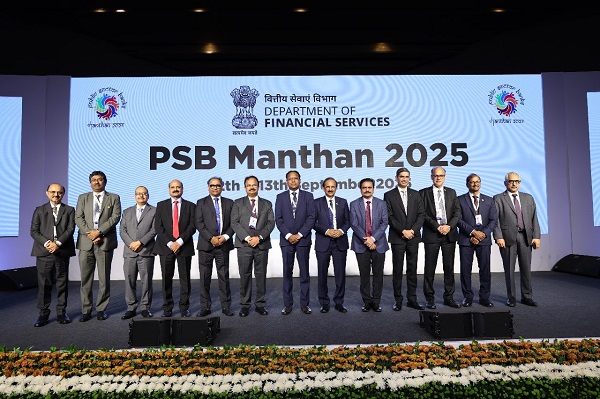.png)

By K. Srinivasa Rao
Kembai Srinivasa Rao is a former banker who teaches and usually writes on Macroeconomy, Monetary policy developments, Risk Management, Corporate Governance, and the BFSI sector.
October 17, 2025 at 8:53 AM IST
The government, in its first move to introduce private-sector leadership styles in public-sector banks, opened the positions for five PSBs in April 2015 through a public advertisement with specific criteria for selection and induction.
Against five positions, only two private-sector executives were ultimately appointed in August 2015 to lead Bank of Baroda and Canara Bank. The individual who headed Canara Bank was previously a PSB executive from SBI and was leading Lakshmi Vilas Bank when chosen for the top role. Therefore, the response from private-sector leaders to head PSBs was lukewarm. Their tenures ended in 2018–19 without a noticeable change in operational results, broadly keeping pace with their peers.
The growth of private-sector-led PSBs and others followed similar trends, with differences in pace mainly due to each bank’s size and scale. The government did not pursue the policy further. As usual, subsequent selections for whole-time directors came from the PSB pool, while the chairperson—a non-executive head—was appointed by the government.
Recently, the government has sought to accelerate the growth of public sector banks through a blended approach. By leveraging internal talent alongside experienced professionals from the private sector, it aims to enhance speed, efficiency, and entrepreneurial dynamism.
Top leadership positions, including Managing Director, Executive Director, and Non-Executive Chairperson, at PSBs are now open to candidates from both the public and private sectors. This expanded scope also includes leaders from the Life Insurance Corporation and non-life insurance companies, subject to specific eligibility criteria. Initially, some top positions are reserved for private-sector candidates, while others will continue to be filled from the PSB pool to create a balanced leadership mix.
The government’s reasoning appears to be to promote leadership diversity, foster merit-based and cross-sector talent mobility, and enhance PSB performance through reform and innovation.
There is a noticeable difference in leadership styles between private-sector and public-sector CEOs in India, with distinct approaches to decision-making, innovation, risk management, and employee engagement.
When banks must be guided to support aspirational growth targets aimed at realising the vision of Viksit Bharat 2047, the leadership pool must align with the necessary level of assertiveness in risk appetite. A combination of stability and risk-taking must ensure risks remain within tolerance limits to sustain long-term strength.
The Foundation
The social tilt is visible in the Pradhan Mantri Jan Dhan Yojana accounts. Out of 56 million PMJDY accounts, 76.2% are with PSBs and RRBs.
The workforce recruited during the expansion of PSBs in the 1980s and 1990s was trained to expand banking reach and focus on priority-sector lending to ensure fair resource distribution and support economic growth.
Banking-sector reforms, which started in 1991, transformed PSBs into competitive outfits expanding in both scope and complexity through interoperable technology. Progressively stringent prudential norms brought in structural changes in how banks build their balance sheets.
The implementation of Income Recognition and Asset Classification norms, along with capital adequacy and provisioning standards, shifted focus from pure service orientation to profitability as well. Despite age limitations and digital skill gaps, PSBs have effectively navigated technology-driven digital banking and compete with their private-sector counterparts.
Having established a foundation of service orientation built on socio-economic objectives and strong value systems, the government expects PSBs to retain these values even while matching the pace and scale of private peers.
The Challenges
Naturally, senior leaders two levels below are also unlikely to join PSBs unless motivated by pride and the chance to influence large government-owned entities. The satisfaction of leading a large state-owned institution must outweigh pay disparities—a challenging expectation.
The functional autonomy of PSBs is subject to Central Vigilance Commission guidelines and the Right to Information Act, whereas private-sector banks are outside the CVC’s purview and largely exempt from the RTI Act.
Due to government ownership, directions from the Department of Financial Services are mandatory for PSBs but only advisory for private banks.
The “hire-and-fire” policy used by private banks to manage staff generally does not apply to PSBs, where the mindset is focused on lifetime employment. Rewarding merit in government-owned entities is not easy, whereas instant recognition is possible in the private sector.
Way Forward
The effort to adopt enterprising leadership similar to private banks will require creating a level-playing field in PSBs. There has to be a productivity-linked incentive structure attractive enough to rival private peers. Appointing top leadership positions alone may not achieve the desired change.
Senior leaders supporting top management must be exposed to private-bank operations through exchange programmes and trained to develop risk appetite and marketing skills, extending leadership down to operational levels across the organisation.
The support structure of line management must effectively translate top-down leadership into measurable performance outcomes. The goal of changing the leadership ecosystem must be impactful enough to produce significant financial results in shorter periods while managing inherent business risks, thereby serving the intended purpose.




